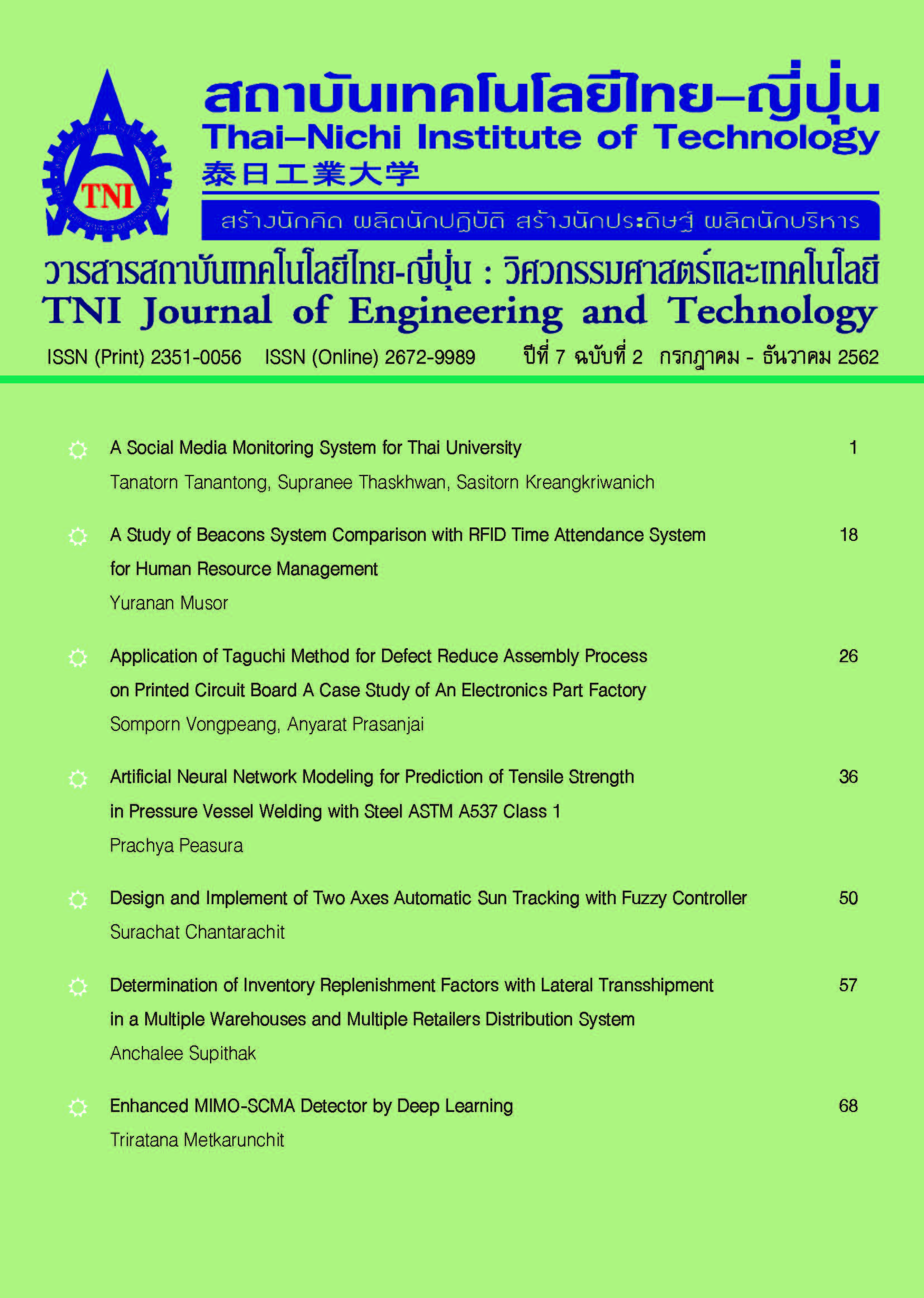Enhanced MIMO-SCMA Detector by Deep Learning
Main Article Content
Abstract
In this paper, we propose a deep learning approach for multiple input multiple output - sparse code multiple access (MIMO-SCMA) signal detection by using a deep neural network via spreading the procedure of the message passing algorithm (MPA). The MPA can be transformed into a sparsely connected neural network. The neural network can be trained off-line and then implemented for online detection. Besides when the neural network has been trained, the network weights corresponding to the edges of a factor graph. From the simulation result of the MIMO-SCMA system over the quasi-static Rayleigh fading channel, found that the neural network detection better performance than the traditional MPA.
Article Details
Article Accepting Policy
The editorial board of Thai-Nichi Institute of Technology is pleased to receive articles from lecturers and experts in the fields of engineering and technology written in Thai or English. The academic work submitted for publication must not be published in any other publication before and must not be under consideration of other journal submissions. Therefore, those interested in participating in the dissemination of work and knowledge can submit their article to the editorial board for further submission to the screening committee to consider publishing in the journal. The articles that can be published include solely research articles. Interested persons can prepare their articles by reviewing recommendations for article authors.
Copyright infringement is solely the responsibility of the author(s) of the article. Articles that have been published must be screened and reviewed for quality from qualified experts approved by the editorial board.
The text that appears within each article published in this research journal is a personal opinion of each author, nothing related to Thai-Nichi Institute of Technology, and other faculty members in the institution in any way. Responsibilities and accuracy for the content of each article are owned by each author. If there is any mistake, each author will be responsible for his/her own article(s).
The editorial board reserves the right not to bring any content, views or comments of articles in the Journal of Thai-Nichi Institute of Technology to publish before receiving permission from the authorized author(s) in writing. The published work is the copyright of the Journal of Thai-Nichi Institute of Technology.
References
[2] Fabio Giust, Luca Cominardi, and Carlos J Bernardos, “Distributed mobility management for future 5G networks:overview and analysis of existing approaches,” IEEE Communications Magazine, Vol. 53, No. 1, pp. 142–149, 2015.
[3] Mamta Agiwal, Abhishek Roy, and Navrati Saxena, “Next generation 5G wireless networks: A comprehensive survey, IEEE Communications Surveys & Tutorials, Vol. 18, No. 3, pp. 1617–1655, 2016.
[4] F. Wei and W. Chen, “A low complexity SCMA decoder based on list sphere decoding,” in Proc. IEEE GLOBECOM, Washington, DC, USA, Dec. 2016, pp. 1–6.
[5] M. Alam and Q. Zhang, “Performance study of SCMA codebook design,” in Proc. IEEE WCNC, San Francisco, CA, Mar. 2017, pp. 1–5.
[6] F. R. Kschischang, B. J. Frey, and H. A. Loeliger, “Factor graphs and the sum-product algorithm,” IEEE Trans. Inf.Theory, Vol. 47, No. 2, pp.498–519, Feb. 2001.
[7] Chaoyun Zhang, Pan Zhou, Chenghua Li, and Lijun Liu, “A convolutional neural network for leaves recognition using data augmentation,” In Proc. 2015 IEEE Int.Conference on Computer and Information ; Ubiquitous Computing and Communications; Dependable, Autonomic and Secure Computing; Pervasive Intelligence and Computing, Liverpool, UK, Dec. 2015, pp. 2143–2150, DOI: 10.1109/CIT/IUCC/DASC/PICOM.2015.318
[8] Richard Socher, Yoshua Bengio, and Christopher D Manning,“Deep learning for NLP (without magic),” In Proc. 50th AnnualMeeting of the Association for Computational Linguistics:Tutorial Abstracts, Jeju Island, Korea, Jul. 2012, p. 5.
[9] Chaoyun Zhang, Paul Patras and Hamed Haddadi, “Deep Learning in Mobile and Wireless Networking: A Survey,” IEEECommunications Surveys & Tutorials, Vol. 21, No. 3, pp.2224 - 2287, Mar. 2019, DOI: 10.1109/COMST.2019.2904897
[10] Akhil Gupta and Rakesh Kumar Jha, “A survey of 5G network: Architecture and emerging technologies,” IEEEAccess, vol. 3, pp. 1206–1232, 2015.
[11] Chunxiao Jiang, Haijun Zhang, Yong Ren, Zhu Han, Kwang-Cheng Chen, and Lajos Hanzo, “Machine learning paradigmsfor next generation wireless networks,” IEEE WirelessCommunications, Vol. 24, No. 2, pp. 98–105, 2017.
[12] Duong D Nguyen, Hung X Nguyen, and Langford B White,“Reinforcement learning with network-assisted feedback for heterogeneous rat selection,” IEEE Transactions onWireless Communications, Vol. 16, No. 9, pp. 6062 – 6076, Sept. 2017, DOI: 10.1109/TWC.2017.2718526
[13] Fairuz Amalina Narudin, Ali Feizollah, Nor Badrul Anuar, and Abdullah Gani, “Evaluation of machine learningclassifiers for mobile malware detection,” Soft Computing,Vol. 20, No. 1, pp. 343–357, 2016.
[14] Wencong Xiao, Jilong Xue, Youshan Miao, Zhen Li, Cheng Chen, Ming Wu, Wei Li, and Lidong Zhou, “Tux2: Distributedgraph computation for machine learning,” in Proc. 14thUSENIX Symposium on Networked Systems Design andImplementation (NSDI ’17), Boston, MA, USA, Mar. 2017, pp.669–682.
[15] Timothy J O’Shea, Tugba Erpek, and T Charles Clancy,“Deep learning based MIMO communications,” Accessed: Jul. 2017. [Online]. Available: https://arxiv.org/abs/1707.07980
[16] Minhoe Kim, Nam-I Kim, Woongsup Lee and Dong-Ho Cho,“Deep Learning-Aided SCMA,” IEEE Communications Letters,Vol. 22, No. 4, pp. 720 – 723, 2018
[17] Chao Lu, Wei Xu, Hong Shen, Hua Zhang, and Xiaohu You, “An Enhanced SCMA Detector Enabled by Deep Neural Network,” Accessed: Aug, 2018. [Online]. Available: https://arxiv.org/abs/1808.08015
[18] M. Abadi et al., “Tensorflow: Large-scale machine learning on heterogeneous systems,” Accessed: Aug, 2018. [Online].Available: https://arxiv.org/abs/1603.04467
[19] D. P. Kingma and J. Ba, “Adam: A method for stochastic optimization,” in Proc. 3rd International Conference for Learning Representations, San Diego, 2015, [Online]. Available: https://arxiv.org/abs/1412.6980
[20] Triratana Metkarunchit, “SCMA codebook design base on circular-QAM,” in Proc. Integrated Communication Navigation and Surveillance Conference (ICNS), Virginia,USA, May. 2017, DOI: 10.1109/ICNSURV.2017.8011917
[21] Triratana Metkarunchit, “Achieving Higher Full-diversity Gain of Downlink STBC-MIMO SCMA System,” Journal ofCommunications, Vol. 13, No. 9, pp. 535-539, Sep. 2018.


